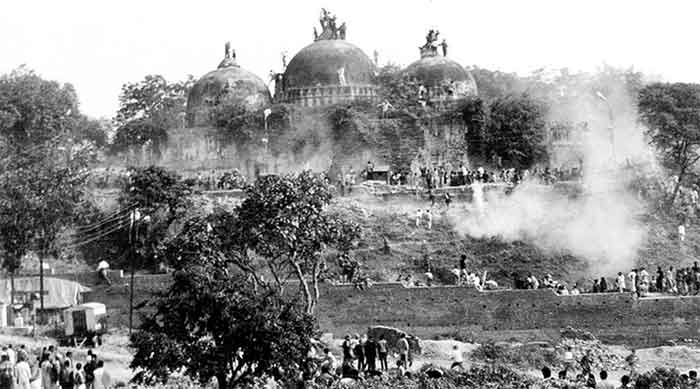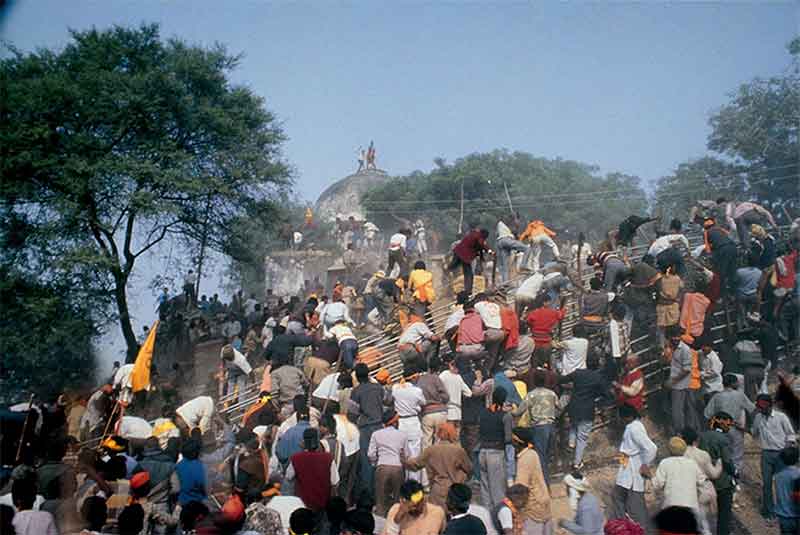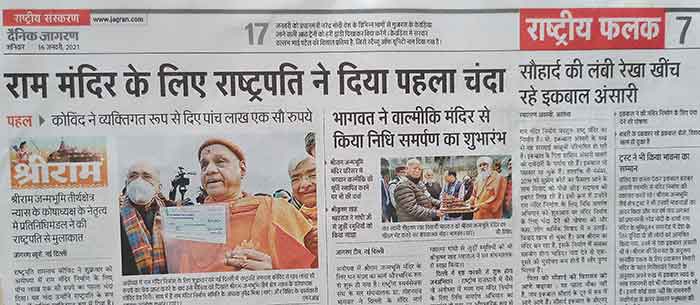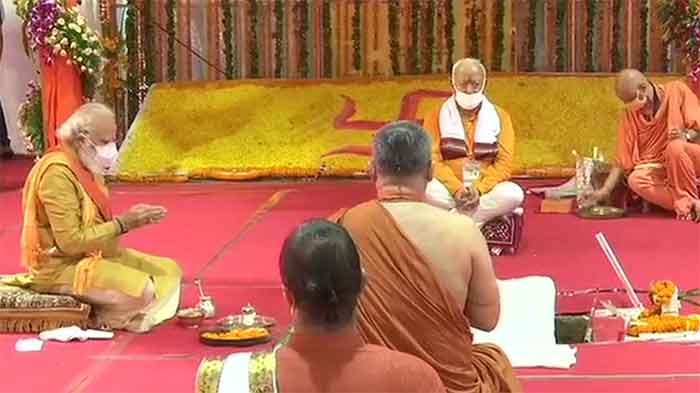
Lord Rama, one of the major deities of Hinduism, was born at the very place of the Babri Mosque in Ayodhya. The mosque was built after the “Muslim invaders” had demolished the Ram Temple. With these historically unsubstantiated narratives, the Hindutva forces, led by the top leaders of the BJP, the VHP and the RSS created frenzied mobs, culminating in the tragic demolition of the Babri Mosque on December 6, 1992. Twenty eight years later, a special court of the CBI, the “premier” investigating agency of the country, has acquitted 32 accused in the Babri demolition case, citing lack of evidence. In its coverage of the CBI’s verdict, the media has against fallen sort of upholding the constitutional principle of secular democracy and rule of law. One Hindi newspaper, while expressing its support to the CBI’s acquittal of 32 accused, wrote an editorial with the title ‘Jai Sri Ram’, a slogan that was popularized by the Hindutva forces during the Ram Temple mobilization.
“It was also rooted in people’s memory that leaders like L.K. Advani and Murli Manohar Joshi did have any direct role [in the demolition of the Babri Mosque”, claims the editorial of Hindi daily Rashtriya Sahara (October 1, 2020). Noteworthy is the editorial’s headline: ‘Jai Sri Ram’ (Victory to Lord Ram). People, particularly the minorities, have not forgotten how the slogan of ‘Jai Sri Ram’ was raised by the Hindutva forces for asserting the supremacy of Hindus. Not only that, the slogan invoked a feeling of hatred against the Muslim minority and neighboring Pakistan. It appears that the daily operated within a contradictory logic. While it was willing to buy the Hindutva forces’ logic that the demolition of the Ram Temple indeed took place some four hundred years back by Muslims, it was unwilling to accept that Babri Mosque was brought down through a conscious political conspiracy.
Another Hindi daily Pioneer, in its attempt to defend BJP top leaders, passed all blame on the “frantic mob” (utejit bhid). In its editorial (October 2), the daily argued: “the act [demolition] was carried out by the frantic mob. The identification of the mob and collecting evidence is a difficult task as they have acted [demolished the mosque] out of excitement”. The newspaper, before putting forth such an excuse, did not think for a while that the so-called excitement and the frenzy, which the mob was possessed with, were not the product of spontaneity but were consciously created over the years through the sustained hateful campaign against the minority Muslims. Well-known photojournalist, Praveen Jain, had captured in his camera the images of ‘dress rehearsal” organized by the VHP to professionally impart training to its cadres about how to demolish the Babri Mosque.
Dainik Jagran was also at forefront in celebrating the CBI’s verdict. In its editorial (October 1), the daily called the naming of top BJP leaders in the Babri demolition case as an example of “narrow-minded politics” (sankirn rajniti). “It [the CBI’s verdict] gives a clear message that blaming the BJP leaders for the demolition of the Babri Masque 28 years back is the result of narrow-minded politics”. Ironically, the daily is eager to accept the CBI judgment which has failed to collect evidence against those responsible for the demolition of the mosque but it is critical of secular parties and intellectuals for disputing the claim of the Hindutva forces about the demolition of the Ram Temple and subsequent construction of the Babri Mosque on its place. Coming hard on the secular forces, the daily wrote that “they were not only seeking evidence for Ayodhya, as the birthplace of Lord Rama, but also turning away from the questions, i.e., if “invaders” Babar and his commander Mir Baqi had a role in destruction of the Ram Temple.”
Hariboomi (October 1), similarly, uncritically accepted the CBI’s verdict that the demolition was spontaneous and not pre-planned. Not only does the daily ask the opposition party, the Congress, to apologize to Advani but also to the whole nation for filing cases against the BJP leaders out of political interests. Amar Ujala (October 1) also penned an editorial with the title “Finally acquitted” (Aakhirkar bari). The daily has also toed the establishment’s line and said that the decision of the court should be respected, even though it has failed to identify the culprits and produce the evidence against them. Hindustan (October 1), too, calls for looking ahead by forgetting the past. With this logic, it welcomed the verdict and ended up upholding the Hindutva narrative.
Unlike Hindi dailies, the Urdu dailies raised several questions over the verdict. For example, Inquilab (Mumbai, October 1) wrote an editorial titled “No one is criminal!” (Mujrim koi nahin hai!). “If a crime has been committed, it is not possible that there would have been no criminal. But the way all the accused in the Babri case have been acquitted makes one believe that there was no criminal. That is why the verdict has caused surprise as well as disappointment…The way the mosque was demolished in a short duration shows that it was not an act of spontaneity”, Inquilab commented in its editorial. Siasat (Hyderabad, October 1) wrote an editorial whose title is self-explanatory: “Justice is dead in India” (Hindustan se insaf khatam).
English dailies also raised questions on the CBI verdict. The Hindu (October 1) wrote an editorial titled “Justice in ruins”: “A Special CBI Court in Lucknow has now cleared the remaining debris with an unconscionable judgment. Throwing to the winds the Supreme Court’s observations on the demolition, the trial court has in effect given judicial legitimation to the ‘Ram Janmabhoomi movement’ by acquitting all those indicted for conspiracy to bring down the structure. Its conclusions are drastic and defy logic and fact. The court’s finding that the demolition was not planned in advance flies in the face of the entry of more than a hundred thousand volunteers into Ayodhya that day, armed with crowbars, spades, hoes and ropes and every implement needed to bring down a sturdy structure and clear the site. The proponents of the movement, headed by L.K. Advani, Murli Manohar Joshi and Uma Bharti among others, had positioned themselves in vantage points to witness the occasion and celebrate with pride what ought to have caused shame and disgust”. The Indian Express (October 1), in its editorial, asks the CBI to “appeal against the verdict so that the justice process can run its full course”. Questioning the finding of the CBI court, the English daily said, “The razing of the masjid, after all, was a public event. It was followed by communal riots in which lives were lost, and, significantly, it was preceded by a highly publicised and carefully crafted movement which had spelt out its goal: ‘Mandir wahin banayenge’, a temple will be constructed where the masjid stands. The BJP-VHP whipped up visible mobilisations, LK Advani’s rath yatras happened in full public view, and from Ayodhya on D Day, there were eyewitness accounts, photos and videos of the bringing down of the masjid amid exhortations of ‘ek dhakka aur do…’.”
The Hindustan Times (October 1) wrote that the CBI “judgment raises more questions than it answers”. “The CBI court verdict raises pertinent questions about the nature and quality of the probe. After years of investigation, CBI presented around 350 witnesses and 600 pieces of documents — but the verdict found that the tapes were tampered with and the documents could not be relied on. This is a further indictment of India’s creaky criminal justice system. The verdict points to anti-social elements who demolished the mosque, but there is no clarity on who they were and whether the probe agencies have any plan to identify and punish them. The conclusions also appear to contradict the findings of the 1992 Liberhan commission that blamed senior political leaders for the event”. The Times of India (October 1), in its editorial, questions the CBI saying the “the Babri Masjid demolition was a criminal act. But CBI fails to prove a conspiracy”.
However, the lead story of The Telegraph (October 1) wrote very critical in its approach towards the mockery of justice made by the CBI court. Along with its story, it carried a picture of an ass. The headline ran that “If we’re indeed shocked, this is what we are [ass]”. Exposing how the CBI verdict has been politically manipulated, the daily contended that “The events that led to December 6, 1992, and September 30, 2020, unfolded right in front of our eyes. We knew without doubt who did it, why they did it and what it cost the nation as blood flowed. Yet, we legitimised them and rewarded them, in election after election — and now we are braying in despair!”
As is evident now, the Hindi press, with the largest circulation, has gone far ahead than other newspapers in toeing the establishment’s line. It is not even ready to critique a case of lawlessness, frenzied mobilization, bloodbath, and fascistic assault on the secular constitution of the country.

(Abhay Kumar is a Ph.D. from JNU. He is broadly interested in Minority and Social Justice. Earlier, he held a Post-Graduate Diploma in English Journalism from the Indian Institute of Mass Communication, New Delhi, and worked as a Delhi-based reporter with The Indian Express. You may write to him at [email protected]).
SIGN UP FOR COUNTERCURRENTS DAILY NEWSLETTER














































